Marvelous Mozzani!
The Incredible Harp Guitars of Luigi Mozzani
by Gregg Miner
Marvelous Mozzani!
The Incredible Harp Guitars of Luigi Mozzani
by Gregg Miner
Chapter 4: Mozzani's Harp Guitar Forms: Dual Arm
|
While the general dates of the discovery of the Schenck instruments and the various Mozzani workshops are known, there isn't clear information about the actual production years in which the various harp guitars were introduced and built. Apparently, few contain a dated label. Generally, 1910 (immediately after the Schenck discovery) through 1920 are given, though the various workshops and "laboratory-schools" were in operation until 1947, and one instrument in the Intelisano book shows a 1942 mark. Perhaps certain models or styles were introduced and built at different times. Mozzani's career, instruments, clientele and general world remain almost unknown to most American guitarists and collectors today. Hopefully, with the opportunities available via the Internet, I will continue to receive information and communication from additional sources - to continually paint a larger picture of those responsible for both the remarkable Mozzani harp guitars and the Schenck legacy as well. NOTE 3 Before I present the vast array of Mozzani harp guitars, I need to discuss nomenclature. We know that Mozzani referred to all of his hollow-arm harp guitars as "chitarra-lyra" - whether they had two arms or one. If you've read my Organology thesis What is a Harp Guitar?, you'll see that I consider them a form of true harp guitar. Unfortunately, Mozzani's choice of name, though romantic, was a poor one - and definitely inappropriate for the single-arm models. He also seems to have ignored the fact that a hundred years earlier the name "lyre guitar" had been applied to (and became standard for) a much more appropriate instrument: a 6-string guitar with more truly "lyre-like" decorative arms, with a base for standing upright (see Lyre Guitar Gallery). Therefore, while Mozzani's specified name cannot be invalidated, it can and should be used sparingly, in a historical sense. Though I list them under his original names, please remember that they are above all harp guitars! Chitarra lyra a due bracci ("double-armed lyre-guitar") |
| NOTE: As of yet, I have no idea what the
timeline of Mozzani's designs is. Hopefully, someday I'll be able to
arrange them by date of introduction. One of Mozzani's designs was a near duplicate of the Schenck double-arm form, with Mozzani trading the hollow headstock rimmed with tuners for a more standard neck that could be completely adjusted within the body/head frame via a series of six bolts! |
| The art deco-looking model with "gingko leaf" soundhole pattern (first 3). |
| Continuing the same body shape. These "oak leaf" pattern instruments are all slightly different. The second has an extra leaf hole (or possibly acorn) in the left arm; the third is missing the right arm soundhole. The fourth appears identical to the third, but is sitting on a stand used in playing position - the third instrument's stand is for playing seated. |
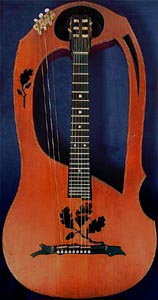
|
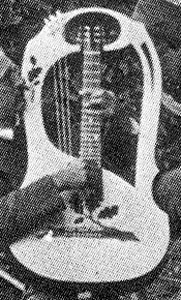 |
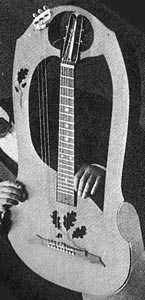 |
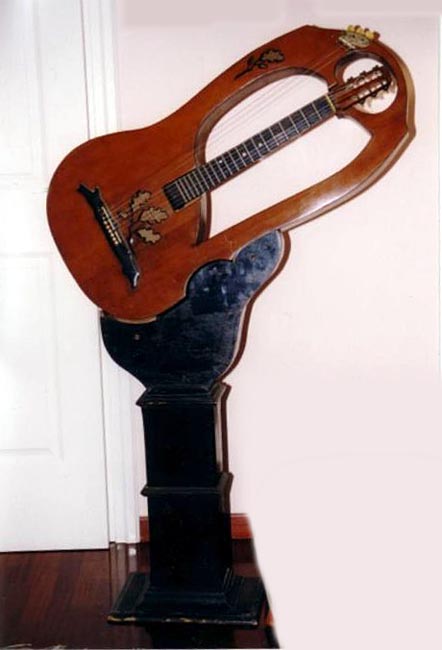 |
| Serial #109 | Stand |
|
Here we see an attempt to lengthen the sub-bass strings by adding an extension (and sometimes an extension on the extension) to the bass tuner area. All use the "gingko leaf" pattern. |
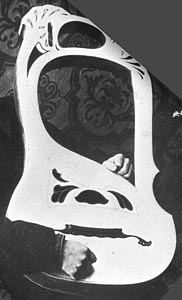 |
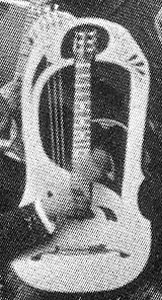 |
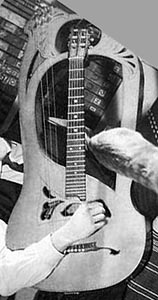 |
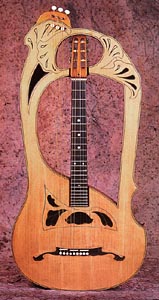 |
| Mozzani is seen holding this unfinished guitar in the book Note how in this model, the sub-bass strings have been lengthened. | Elsewhere in the book, a friend is seen playing this seemingly identical instrument, now finished. | Benoit Meulle-Stef informs me that this is also "one of Mozzani's personal instruments." Could all 3 of these be an image of the same guitar? | This example is nearly identical, but has a slightly
different shape to the bass extension. (image copyright and courtesy Vintage Guitar Books)
Additional images of this wonderful instrument, including a
unique carved back! (thanks to Jim Forderer for letting me photograph it)
|
| Keeping the longer length of the sub-basses, but with an altered shape. |
|
Credits/Sources: See Table of Contents |
|
|
|
All Site Contents Copyright © Gregg Miner, 2004,2005,2006,2007,2008,2009. All Rights Reserved. Copyright and Fair Use of material and use of images: See Copyright and Fair Use policy. |